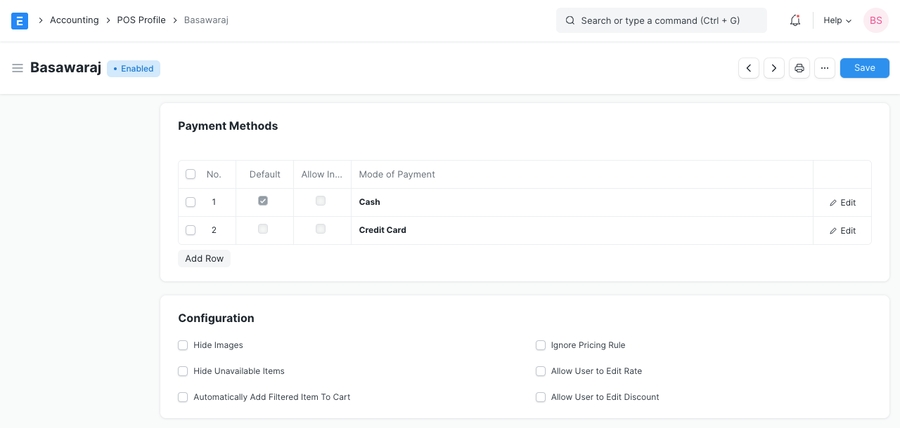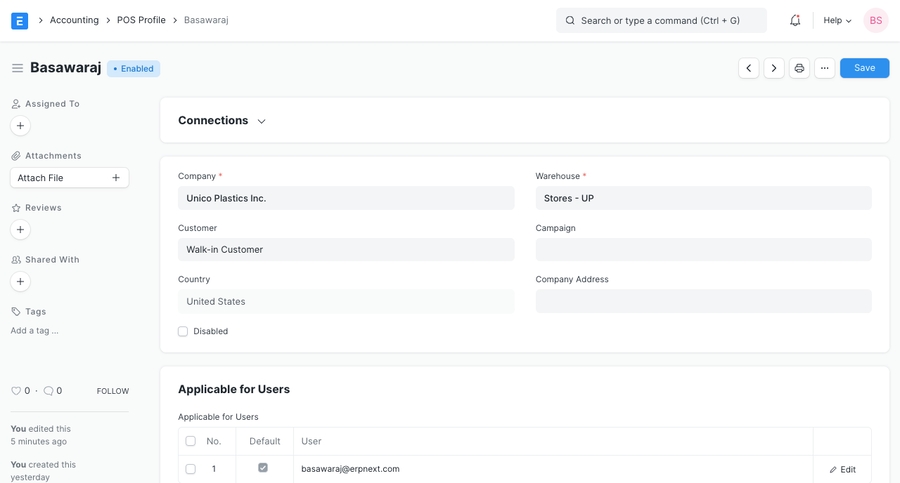Point of Sale Profile
In ActiveBooks, a POS profile allows using the Point of Sale feature.
POS includes advanced features to cater to different functionality, such as inventory management, CRM, financials, warehousing, etc., all built into the POS software.
Before modern POS, all of these functions were done independently and required the manual re-keying of information, which could lead to entry errors.
If you are in retail operations, you want your Point of Sale to be as quick and efficient as possible.
To do this, you can create a POS Profile for a user.
To access the POS Profile list, go to:
Retail > Settings and Configurations > Point-of-Sale Profile
Go to the Point-of-Sale Profile and click on New.
Enter a name for the profile.
Select a Naming Series.
Set a Write Off Account and Write Off Cost Center to which the transactions will be recorded.
Set up payment modes in the table, the default will be cash if nothing is set here.
Only the modes set here will be available when using POS.
After adding payment modes, set one of them as the default payment method by ticking the checkbox.

Set the default amounts for the payment methods (recommended: 0).
Save.

Customer: Users can sell particular products to the particular Customers from the POS by adding item groups, customer groups in the POS Profile.
Warehouse: The stock quantities in the selected Warehouse will be affected for POS transactions with this POS Profile.
Campaign: A sales Campaign can be linked here to track total sales against it.
Company Address: If the POS counter is set up at a Company branch, the address can be selected here.
Ignore Pricing Rule: Any active Pricing Rule will be ignored for this POS Profile.
Allow user to edit Rate: The POS Profile user will be allowed to edit the 'Rate' of Items added in transactions.
Allow user to edit Discount: The POS Profile user will be allowed to edit the 'Discount' of Items added in transactions.
By default, all Sales Users can access the POS Profiles created in ActiveBooks.
However, if you want only certain Users to access certain POS Profiles, you can add them to the table.
Once even one User is set in the POS Profile, other Users cannot use this POS Profile for retail transactions.
Setting POS Profile as default: On ticking the Default checkbox in the table, the current POS Profile becomes the default POS Profile for that User. So, the next time the User logs into the system, the POS Profile will be set by default.

Note: If you specify a particular User, the POS setting will be applied only to that User. If the User option is left blank, the setting will be set for all users.
On setting an Item Group/Customer Group in a POS Profile, the group will be automatically selected when making transactions with the POS Profile.


Print Format for Online
You can set a Print Format which will decide what the layout of the printed document will look like.
Letterhead
You can print your POS Sales Invoice on your Company's letterhead.
Print Headings
POS Sales Invoice headings can also be changed when printing the document. For example, the heading can be 'Invoice', or 'Bill'. You can do this by selecting a Print Heading. To create new Print Headings go to:
Settings > Printing > Print Heading.
Terms and Conditions
There may be certain terms and conditions on the Item you're selling, these can be applied here.
ActiveBooks is an online tool that runs using the internet. However, you can use the POS feature in ActiveBooks offline.
To do so, first enable 'Use POS in Offline Mode' in POS Settings.
When online, the POS window will show 'Online', otherwise, the POS system is being used offline.
Then the following can be configured in the POS Profile:
Territory
Print Format
Customer Group

Price List: A Price List stores the Item Prices. Setting a Price List here will fetch the Item Prices for the current POS Profile from that Price List.
Currency: By default, this will be set according to the Company's default currency. However, you can change it. In case you change the currency, remember to change the accounts too.
Taxes and Charges: Selecting a Sales Taxes and Charges Template or Purchase Taxes and Charges Template here will automatically apply the taxes and charges to the POS transaction.
Apply Discount On: Here you can set whether the discount is to be applied on the Grand Total (pre tax amount) or the Net Total (post tax amount).
Tax Category: On selecting a Tax Category here, the Tax Rules associated with the Tax Category will be applied to each transaction performed from this POS Profile.
The following accounts can be set so that the general ledger is updated accordingly:
Account for Change Amount
Write Off Account
Write Off Cost Center
Income Account
Expense Account
Accounting Dimensions lets you tag transactions based on a specific Territory, Branch, Customer, etc. This helps in viewing accounting statements separately based on the criteria selected.
Note: Cost Center is treated as a dimension by default.
Last updated
Was this helpful?